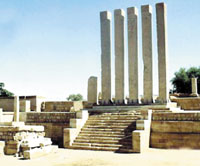
Marib: Land of heavens and thrones [Archives:2005/887/Last Page]
October 20 2005
 |
BY YASSER AL-MAYASI
YEMEN TIMES STAFF
& ESHRAQ AL-BODIGI
FOR THE YEMEN TIMES
Marib is one of the most famous ancient cities in Yemen. It was the capital of the Sheba Kingdom for several centuries, and is situated 173 km east of Sana'a. Its location was the controlling point of the ancient caravan route of the Arabian Peninsula, and the connecting link of the Silk Road starting from Southeast Asia.
Its fame dates back to the glory of the Shebaen civilization, the traces of which is still visible through the archeological monuments many of which still buried underground.
Marib Governate includes 12 provinces among which are Marib, Serwah, Rahaba, Horeib, and Magzar with Barakesh, a famous ancient city which dates back two the 7th century B. C. It is the second city after Ma'aen, the capital of the Ma'aen country.
Agriculture and sheep are considered at the top of the list of economic activities in this governate, and these are extensions of Marib's old activities and civilizations. In the area people produce crops such as seeds, fruits, and vegetables.
The great Marib dam
This dam is considered the symbol of the Sheba kingdom, as it reflects the zenith of its power, while at the same time marking of its downfall. According to inscriptions, the dam was constructed in the 8th century BC. Whatever the starting point of construction, the great Marib dam continued to be a working monument through all ages of Yemen civilization. Inscriptions indicate that the dam collapsed and was renovated several times. The last time major work was carried out on the dam was during the Abyssinian occupation of Yemen in the 6th century AD.
The dam is 35 m high, 720 m long and 60 m wide and the foundations were built of bulky pieces of rock covered with rough volcanic stones. At the tip of the dam two gaps were left open through which water flowed into the irrigation system and canals, and the surface of the exterior wall was covered with rough volcanic stones. The wall of the two openings, Al-Sadafain, still exists, as described by Al-Hamadani more than 1000 years ago. The clever irrigation system was centered on the collection of water flowing from a number of valleys. When the water level was high irrigation of the largest area of the land was possible.
The Marib Dam is considered the most famous archeological monuments in Yemen, and the greatest technically constructed object of archeology ever to be build in the Arabian Peninsula. It was erected between the northern and central Balak Mountains, 8 km southwest of Marib city, and 167 km from Sana'a. Two of its main controlling water banks are still in good shape. Today, Marib also has a new dam close to the ancient one, built after the 26 September Revolution.
Ancient Temples of Marib
Bilqis Shrine
The Bilqis Shrine is the most famous and important temple in Marib. Its original name is Awam Temple, and the ancient Yemenies called it Al-Shams Temple, the temple of the sun. The latter was the worshiping goddess of \”Al-Maqa\””


